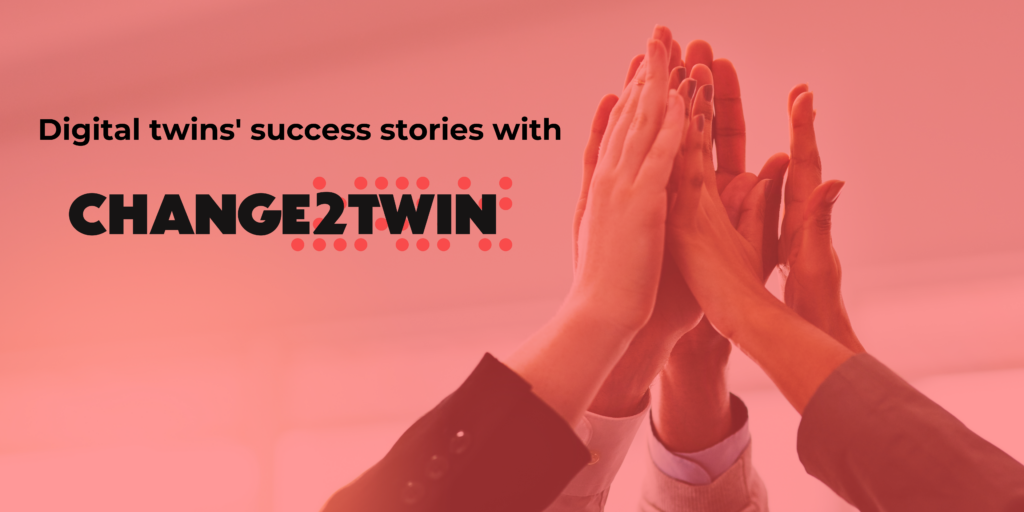Check out the catalogue of digital twins’ success stories powered by Change2Twin and learn how the most advanced technology is helping the manufacturing industry build a new generation of fully digitalised European companies.

Digital twins helping to successfully ensure the green and digital transition
Digital twin technologies are transforming industries and improving quality of life by offering advanced production optimization, decision-making, and resource management solutions. By recognizing its potential in the Towards a green & digital future report (2022), the European Commission has been actively supporting numerous initiatives aimed at integrating digital twin technologies into daily life across Europe. The most emblematic one is without hesitation Destination Earth (DestinE) which is a flagship initiative of the European Commission to develop a highly accurate digital model of the Earth on a global scale. DestinE will address complex environmental challenges by monitoring Earth’s systems and human impact, anticipating disasters to save lives and prevent economic loss, and testing scenarios for sustainable development to enhance environmental resilience. These efforts not only give Europeans the chance to experience the benefits firsthand but also promote widespread adoption across various sectors. If artificial intelligence (AI) represents a technological revolution, digital twins are the key that can liberate its full potential. Furthermore, DIGITAL programme will invest €20 million to advance the connection, development, and deployment of Local Digital Twins (LDTs) across the EU. The successful projects will aim to help cities and communities harness economies of scale in data platform development and AI-based solutions.
The Digital twin dream team: European digital innovation hubs, technological providers, and related European projects
Europe can already be proud of having the top 10 digital twins’ companies such as Siemens, Bosch, Aveva. Technological providers are essential and their capacities to develop software aligned with the manufacturing sector’s needs are crucial. This competitive advantage can definitively help and convince many companies to adopt the technology but what can trigger such transformation is mainly the financial help. Nevertheless, European Digital Innovation Hubs (EDIHs) can also be a perfect link to support companies in implementing a digital transformation strategy since there are equipping companies with the essential digital tools to improve their competitiveness, upgrade their infrastructure, and boost their overall digital capacities. The association can offer services such as testing the technology before adopting it, receiving trainings and improve skills, finding financial support, and be part of major network. Check the map, your DIH may be just around the corner. Finally, the European funded projects are essential for all types of companies to benefit from financial help, mentoring and more through open calls.
But the key to success is of course the union of those three strengths and this is how Change2Twin has been working since 2020. The EU-funded project under I4MS, helped manufacturing SMEs and mid-sized companies adopt digital twin technology to boost competitiveness. With the support of 18 European partners, the initiative offered tailored support, from assessing digital potential to providing personalized mentoring and a step-by-step deployment plan. Change2Twin also provided funding to cover digital readiness assessments and implementation costs, making digital twins more accessible for manufacturers looking to enhance their operations.
Find your twin project by consulting the brochure Digital Twin Champions in Manufacturing: Success Stories from Change2Twin Project
If you doubt adopting the technology, the brochure provided by the Change2Twin project will definitively give you the push you were looking for. This brochure offers an exhaustive overview of all cross-sector digital twin experiments carried out in the Change2Twin project from 2020 until 2024.
In order to prove the concept of its financial instruments, Change2Twin carried out four pilot experiments in 2020-2021 with companies from various manufacturing branches. These experiments illustrated the potential of selected digital twin technologies and provided background and inspiration for other manufacturing companies. Aetna Group’s Robopac aimed to develop a digital twin to optimize wrapping strategies, reduce material usage, increase speed, and provided new digital services to customers. Graphenstone planned to create a digital twin of its paint manufacturing process, integrating internal and external data to enhance quality verification, maximize output, and lower operational costs. Additive Industries intended to build a digital twin for its 3D metal printing machinery to ensure compliance with certification standards for high-demand sectors like aerospace and healthcare. Space Structures GmbH utilizeed a digital twin to study the performance of a prosthesis adapter, focusing on how designs can endure higher stress while using less material through additive manufacturing.
After the successful completion of the four pilot experiments, Change2Twin offered its solution to manufacturing SMEs in open calls. In the brochure, you will find information about our support schemes for manufacturing SMEs and the complete portfolio of our beneficiaries, including the pilot experiments. The brochure has hyperlinks, for you to easily navigate to video interviews and testimonials from companies participating in the programme. Have a look at the lessons learned chapter which provides valuable tips for those who want to introduce digital twins to their business.
All success stories are available in the Change2Twin YouTube channel!
Marjorie Grassler